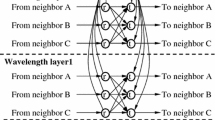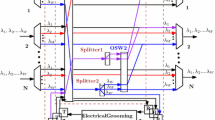Abstract.
In this paper, we consider the problem of traffic grooming in optical wavelength division multiplexed (WDM) mesh topology-based networks, under dynamic traffic conditions. Individual channels in a WDM network have capacities of up to 40 Gbps and are expected to increase further. However, individual connections (or sessions) typically do not require the entire wavelength capacity. Thus, allocating a lightpath with a full wavelength capacity for a single connection results in low bandwidth utilization. One way to solve this is by using electronic SONET add-drop multiplexers (SADMs) at each node to multiplex several low-rate connections on to the high-capacity wavelength channel, and provision them as a single lightpath. This is referred to as traffic grooming. However, SADMs are costly devices and it is expensive to equip each port and wavelength in every node with grooming capabilities. This leads to the concept of limited grooming that requires fewer SADMs at the nodes: only a subset of the ports and wavelengths will be equipped with SADMs. In this paper, we propose four different limited grooming node architectures and develop grooming policies for each architecture. We also conduct a systematic performance evaluation of a limited grooming optical network supporting dynamic traffic requests. We consider the effect of several important factors including: the connection granularity, traffic grooming policy, the number of SADMs at a node, the grooming port tunability and wavelength conversion. The results indicate that limited grooming at each node is sufficient to attain the performance obtained with full grooming, especially when connections occupy a small fraction of the wavelength capacity. Further, the connection granularity, the grooming policy and the number of wavelengths used per link for a connection are also seen to have a significant effect on the blocking performance. Interestingly, the SADM tunability and the port-sharing architecture are not seen to have a significant impact on the performance.
Similar content being viewed by others
References
Ramaswami, R., Sivarajan, K.N.: Optical Networks: A Practical Perspective 2nd edn. Morgan Kaufmann (2001)
K. Sivalingam S. Subramaniam (Eds) (2004) Emerging Optical Network Technologies Springer Boston
K. Zhu B. Mukherjee (2003) ArticleTitleA review of traffic grooming in WDM optical networks: architectures and challenges Opt. Netw. Mag. 4 IssueID2 55–64
R. Dutta G.N. Rouskas (2002) ArticleTitleTraffic grooming in WDM networks: past and Future IEEE Netw. 16 46–56 Occurrence Handle10.1109/MNET.2002.1081765
Sivakumar, M., Shenai, R., Sivalingam, K.M.: Protection and restoration for optical WDM networks: a survey. In: Sivalingam, K., Subramaniam, S. (eds.) Emerging Optical Network Technologies, pp. 297–332. Springer, Berlin Heidelberg Newyork (2004)
Hu J., Modiano, E.: Traffic grooming in WDM networks. In: Sivalingam, K., Subramaniam, S. (eds.) Emerging Optical Network Technologies, pp. 245–264. Springer, Berlin Heidelberg Newyork (2004)
E. Modiano P.J. Lin (2001) ArticleTitleTraffic grooming in WDM networks IEEE Commun. Mag. 39 IssueID7 124–129 Occurrence Handle10.1109/35.933446
X. Zhang C. Qiao (2000) ArticleTitleAn effective and comprehensive approach for traffic grooming and wavelength assignment in SONET/WDM rings IEEE/ACM Trans. Netw. 8 IssueID5 608–617 Occurrence Handle10.1109/90.879347
Hu, J.Q., Leida, B.: Traffic grooming, routing and wavelength assignment in optical WDM mesh networks. In: Proceedings of the IEEE INFOCOM, pp. 495–501, Hong Kong, China, March (2004)
K. Zhu B. Mukherjee (2002) ArticleTitleTraffic grooming in an optical WDM mesh network IEEE J. Selected Areas Commun. 20 IssueID1 122–133 Occurrence Handle10.1109/49.974667
K. Zhu B. Mukherjee (2003) ArticleTitleA comprehensive study on next-generation optical grooming switches IEEE J. Selected Areas Commun. 21 IssueID7 1173–1186 Occurrence Handle10.1109/JSAC.2003.815683
S. Thiagarajan A.K. Somani (2001) ArticleTitleCapacity fairness of WDM networks with grooming capabilities Opt. Netw. Mag. 2 IssueID3 24–31
Thiagarajan, S., Somani, A.K.: A capacity correlation model for WDM networks with constrained grooming capabilities. In: Proceedings of the ICC’01, pp. 1592–1596, Helsinki, Finland, June 2001
Wen, B., Sivalingam, K.: Routing, wavelength and time-slot assignment in time division multiplexed wavelength-routed optical WDM networks. In: Proceedings of the IEEE INFOCOM, pp. 1442–1450, New York, NY, June 2002
Sivakumar, M., Subramaniam, S.: A performance evaluation of time switching in TDM wavelength routing networks. In: Proceedings of the Broadband Optical Networking Symposium, pp. 212–221, San Jose, CA, October 2004
Zhu, K., Mukherjee, B.: On-line approaches for provisioning connections of different bandwidth granularities in WDM mesh networks. In: Proceedings of the Optical Fiber Communication Conference, 549–551, Anaheim, CA, March 2001
I. Chlamtac A. Farago T. Zhang (1996) ArticleTitleLightpath (Wavelength) routing in large WDM networks IEEE J. Selected Areas Commun. 14 IssueID5 909–913 Occurrence Handle10.1109/49.510914
Author information
Authors and Affiliations
Corresponding author
Additional information
Part of the research was supported by a grant from Intel Corporation and NSF grant no. ANI-0322959 at UMBC; and NSF grant no. CNS-0434956 at GWU
Rights and permissions
About this article
Cite this article
Sivakumar, M., Sivalingam, K.M. & Subramaniam, S. On Factors Affecting the Performance of Dynamically Groomed Optical WDM Mesh Networks. Photon Netw Commun 12, 15–28 (2006). https://doi.org/10.1007/s11107-006-0011-8
Received:
Revised:
Accepted:
Issue Date:
DOI: https://doi.org/10.1007/s11107-006-0011-8




